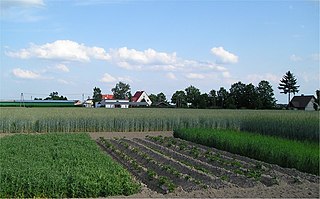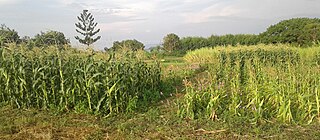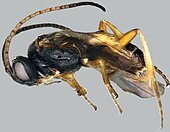
Crop rotation is the practice of growing a series of different types of crops in the same area across a sequence of growing seasons. This practice reduces the reliance of crops on one set of nutrients, pest and weed pressure, along with the probability of developing resistant pests and weeds.

Biological control or biocontrol is a method of controlling pests, whether pest animals such as insects and mites, weeds, or pathogens affecting animals or plants by using other organisms. It relies on predation, parasitism, herbivory, or other natural mechanisms, but typically also involves an active human management role. It can be an important component of integrated pest management (IPM) programs.

Aphids are small sap-sucking insects and members of the superfamily Aphidoidea. Common names include greenfly and blackfly, although individuals within a species can vary widely in color. The group includes the fluffy white woolly aphids. A typical life cycle involves flightless females giving live birth to female nymphs—who may also be already pregnant, an adaptation scientists call telescoping generations—without the involvement of males. Maturing rapidly, females breed profusely so that the number of these insects multiplies quickly. Winged females may develop later in the season, allowing the insects to colonize new plants. In temperate regions, a phase of sexual reproduction occurs in the autumn, with the insects often overwintering as eggs.

Whiteflies are Hemipterans that typically feed on the undersides of plant leaves. They comprise the family Aleyrodidae, the only family in the superfamily Aleyrodoidea. More than 1550 species have been described.

Intercropping is a multiple cropping practice that involves the cultivation of two or more crops simultaneously on the same field, a form of polyculture. The most common goal of intercropping is to produce a greater yield on a given piece of land by making use of resources or ecological processes that would otherwise not be utilized by a single crop.

In agriculture, cover crops are plants that are planted to cover the soil rather than for the purpose of being harvested. Cover crops manage soil erosion, soil fertility, soil quality, water, weeds, pests, diseases, biodiversity and wildlife in an agroecosystem—an ecological system managed and shaped by humans. Cover crops can increase microbial activity in the soil, which has a positive effect on nitrogen availability, nitrogen uptake in target crops, and crop yields. Cover crops may be an off-season crop planted after harvesting the cash crop. Cover crops are nurse crops in that they increase the survival of the main crop being harvested, and are often grown over the winter. In the United States, cover cropping may cost as much as $35 per acre.

Beneficial insects are any of a number of species of insects that perform valued services like pollination and pest control. The concept of beneficial is subjective and only arises in light of desired outcomes from a human perspective. In agriculture, where the goal is to raise selected crops, insects that hinder the production process are classified as pests, while insects that assist production are considered beneficial. In horticulture and gardening, beneficial insects are often considered those that contribute to pest control and native habitat integration.

In agriculture, polyculture is the practice of growing more than one crop species together, in contrast to monoculture, which had become the dominant approach in the 20th century. Traditional examples include the intercropping of the three sisters, namely maize, beans, and squash, by indigenous peoples of Central and North America, and the rice-fish systems of Asia. Polyculture serves multiple functions in the ecology of agriculture, including controlling insect pests, plant diseases, and weeds. Polyculture can contribute to sustainable agriculture as unlike monoculture it does not rely on pesticides, requires less tillage, increases local biodiversity, and where legumes are involved, help to maintain soil nitrogen.

Allelopathy is a biological phenomenon by which an organism produces one or more biochemicals that influence the germination, growth, survival, and reproduction of other organisms. These biochemicals are known as allelochemicals and can have beneficial or detrimental effects on the target organisms and the community. Allelopathy is often used narrowly to describe chemically-mediated competition between plants; however, it is sometimes defined more broadly as chemically-mediated competition between any type of organisms. Allelochemicals are a subset of secondary metabolites, which are not directly required for metabolism of the allelopathic organism.

In agriculture, a living mulch is a cover crop interplanted or undersown with a main crop, and intended to serve the purposes of a mulch, such as weed suppression and regulation of soil temperature. Living mulches grow for a long time with the main crops, whereas cover crops are incorporated into the soil or killed with herbicides.
In agriculture and gardening, a beneficial organism is any organism that benefits the growing process, including insects, arachnids, other animals, plants, bacteria, fungi, viruses, and nematodes. Benefits include pest control, pollination, and maintenance of soil health. The opposite of beneficial organisms are pests, which are organisms deemed detrimental to the growing process. There are many different types of beneficial organisms as well as beneficial microorganisms. Also, microorganisms have things like salt and sugar in them. Beneficial organisms include but are not limited to: Birds, Bears, Nematodes, Insects, Arachnids, and fungi. The ways that birds and bears are considered beneficial is mainly because they consume seeds from plant and spread them through feces. Birds also prey on certain insects that eat plants and hinder them from growing these insects are known as non beneficial organisms. Nematodes are considered beneficial because they will help compost and provide nutrients for the soil the plants are growing in. Insects and arachnids help the growing process because they prey on non beneficial organisms that consume plants for food. Fungi help the growing process by using long threads of mycelium that can reach very long distances away from the tree or plant and bring water and nutrients back to the tree or plant roots.

Push–pull technology is an intercropping strategy for controlling agricultural pests by using repellent "push" plants and trap "pull" plants. For example, cereal crops like maize or sorghum are often infested by stem borers. Grasses planted around the perimeter of the crop attract and trap the pests, whereas other plants, like Desmodium, planted between the rows of maize, repel the pests and control the parasitic plant Striga. Push–pull technology was developed at the International Centre of Insect Physiology and Ecology (ICIPE) in Kenya in collaboration with Rothamsted Research, UK. and national partners. This technology has been taught to smallholder farmers through collaborations with universities, NGOs and national research organizations.

A beneficial weed is an invasive plant that has some companion plant effect, is edible, contributes to soil health, adds ornamental value, or is otherwise beneficial. These plants are normally not domesticated. However, some invasive plants, such as dandelions, are commercially cultivated, in addition to growing in the wild. Beneficial weeds include many wildflowers, as well as other weeds that are commonly removed or poisoned. Certain weeds that have obnoxious and destructive qualities have been shown to fight illness and are thus used in medicine. For example, Parthenium hysterophorus native to northern Mexico and parts of the US has been an issue for years due to its toxicity and ability to spread rapidly. In the past few decades, though, research has found that P. hysterophorus was "used in traditional medicine to treat inflammation, pain, fever, and diseases like malaria dysentery." It is also known to create biogas that can be used as a bioremediation agent to break down heavy metals and other pollutants.
A trap crop is a plant that attracts agricultural pests, usually insects, away from nearby target crops. This form of companion planting can save a target crop from decimation by pests without the use of artificial pesticides. A trap crop is used for attracting the insect and pests away from a target crop field. Many trap crops have successfully diverted pests from focal crops in small scale greenhouse, garden and field experiments; a small portion of these plants have been shown to reduce pest damage at larger commercial scales. A common explanation for reported trap cropping failures, is that attractive trap plants only protect nearby plants if the insects do not move back into the target crop. In a review of 100 trap cropping examples in 2006, only 10 trap crops were classified as successful at a commercial scale, and in all successful cases, trap cropping was supplemented with management practices that specifically limited insect dispersal from the trap crop back into the target crop.

A weed is a plant considered undesirable in a particular situation, growing where it conflicts with human preferences, needs, or goals. Plants with characteristics that make them hazardous, aesthetically unappealing, difficult to control in managed environments, or otherwise unwanted in farm land, orchards, gardens, lawns, parks, recreational spaces, residential and industrial areas, may all be considered weeds. The concept of weeds is particularly significant in agriculture, where the presence of weeds in fields used to grow crops may cause major losses in yields. Invasive species, plants introduced to an environment where their presence negatively impacts the overall functioning and biodiversity of the ecosystem, may also sometimes be considered weeds.

Chloridea virescens, commonly known as the tobacco budworm, is a moth of the family Noctuidae found throughout the eastern and southwestern United States along with parts of Central America and South America.

Macrosiphum euphorbiae, the potato aphid, is a sap-sucking pest insect in the family Aphididae. It infests potatoes and a number of other commercially important crops.

Tritrophic interactions in plant defense against herbivory describe the ecological impacts of three trophic levels on each other: the plant, the herbivore, and its natural enemies. They may also be called multitrophic interactions when further trophic levels, such as soil microbes, endophytes, or hyperparasitoids are considered. Tritrophic interactions join pollination and seed dispersal as vital biological functions which plants perform via cooperation with animals.






















